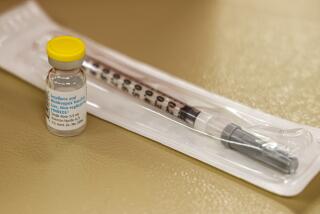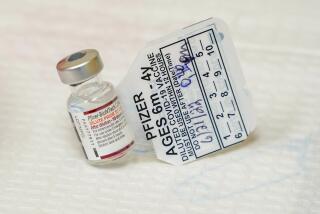Study shows one dose of H1N1 vaccine may be enough for children
Australian researchers have shown that a single dose of vaccine against pandemic H1N1 influenza can provide effective immunity against the swine flu virus in infants and children, a finding that, if corroborated, could help damp the spread of the virus by reducing the logistical complications associated with the currently recommended regimen of two doses.
Immunizing children plays a crucial role in preventing widespread outbreaks of flu and other infectious diseases because schools and camps provide a fertile breeding ground for viruses, which then spread into the community. Early swine flu outbreaks, in New York for example, were triggered by infections in the school system.
But immunizing a large proportion of schoolchildren is a daunting task, and making sure they receive the recommended two doses is doubly difficult. If the Australian results, reported online Monday in the Journal of the American Medical Assn., are correct, that could simplify the process.
U.S. health authorities, however, said the finding will not change their recommendations for children. They pointed out in an accompanying editorial that the Australian study used twice the dosage of viral antigen than is found in U.S. vaccines. Further, they said, the results directly contradict previous studies of seasonal and H1N1 flu vaccines in the United States, and different results might be obtained in different groups of children.
“It remains prudent to continue to follow current recommendations for administering two doses to infants and young children while awaiting definitive vaccine effectiveness data,” wrote Dr. Anthony E. Fiore and Dr. Kathleen M. Neuzil of the Centers for Disease Control and Prevention’s National Center for Infectious Diseases.
At best, the results could provide comfort for parents who are having difficulties getting a second dose of vaccine for their children, said Dr. Danelle Fisher, chairwoman of pediatrics at St. John’s Health Center in Santa Monica. “If we can reassure ourselves that one dose is effective, it could go a long way toward making parents feel better,” she said. Fisher said that in her private practice, she had ordered 2,000 doses of the vaccine but had received only 200.
The need for two doses of seasonal flu vaccine arises because infants and children have had little prior exposure to the flu virus. Adults have generally either previously been exposed to seasonal flu or immunized against it. Either way, the exposure sensitizes the immune system, in effect “priming” it so that one dose of a new vaccine stimulates immunity against new flu strains.
In children who have not been exposed previously, two doses of seasonal flu vaccine are required.
A team headed by virologist Terry Nolan of the University of Melbourne School of Population Health studied 370 healthy infants and children younger than 9. Half were given a 15-microgram dose of an unadjuvanted vaccine produced by CSL Biotherapies of Parkville, Australia, and half received a 30-microgram dose. All were given a second dose three weeks later. Vaccines approved for children in the United States contain 7.5 micrograms of antigen.
After the first shot, 92% of those receiving the 15-microgram dose had fully protective antibody levels.After two doses, 100% were protected. Similar results were obtained with the 30-microgram dose, and no significant side effects were observed at either level.
Fiore and Neuzil cautioned that an unusually high proportion of the children in the study -- 9% to 14% of those younger than 3 and 28% to 33% of those ages 3 to 9 -- had some antibodies against the virus at the beginning of the study. That suggests that either they had some previous exposure to the virus that primed them for the vaccine or that the test used by the Australian researchers to measure antibody levels was unusually sensitive. Also, antibody levels in the children after one dose were about 30% lower than those in adults receiving a similar dose, suggesting that the vaccine may not be as protective as hoped. The study was funded by CSL and the Australian government.






